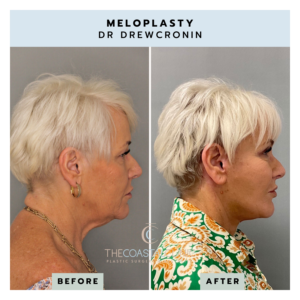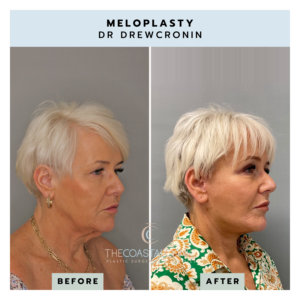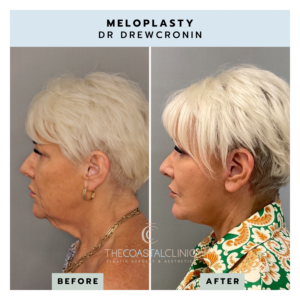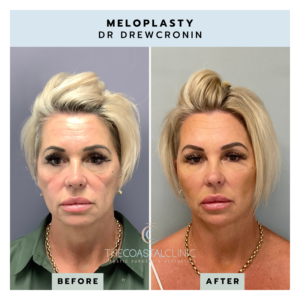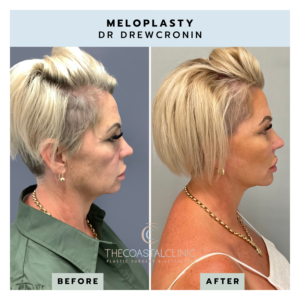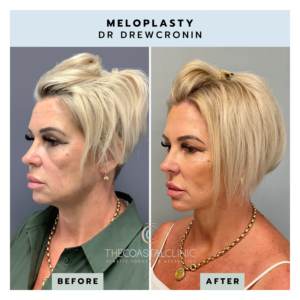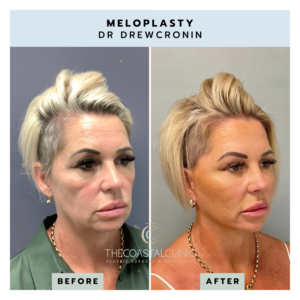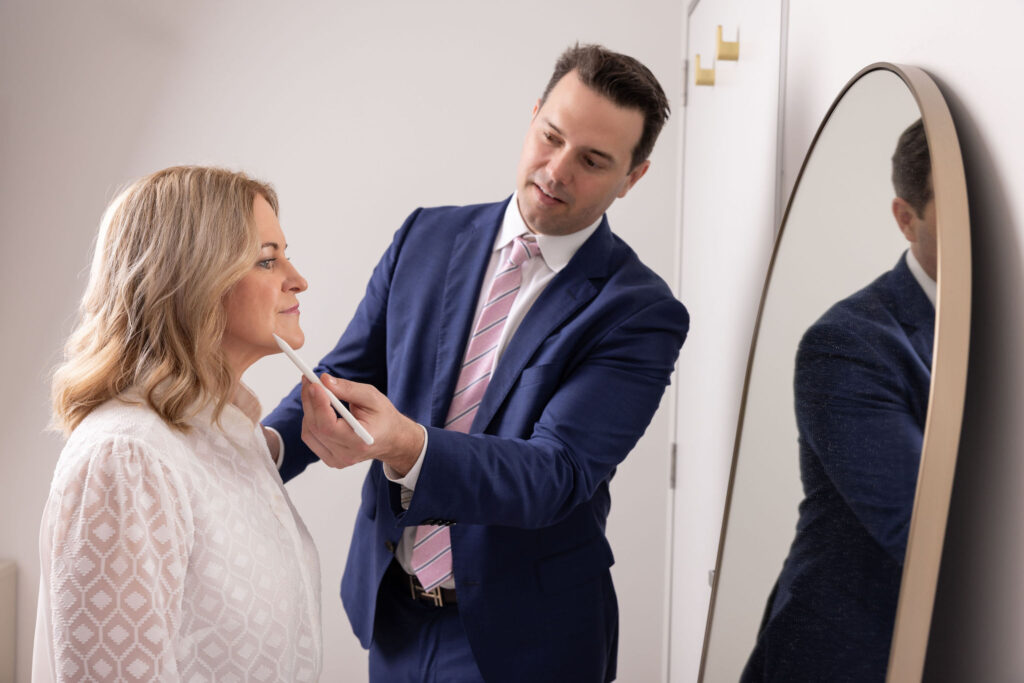
Platysmaplasty (Necklift)
A neck lift, also known as a platysmaplasty, is a surgical procedure aimed at improving the appearance of the neck and jawline.
It addresses issues such as excess skin, fat deposits, and muscle banding in the neck, which can result from aging or significant weight loss. The procedure involves removing or repositioning excess skin and fat, and tightening the underlying muscles.
Who is a good candidate for a neck lift?



A good candidate for a neck lift is someone who:
In Good Health
Has Excess Skin
Muscle Banding
Realistic Expectations
Non Smoker
Definition
Platysmaplasty (Necklift): The Procedure
Content to be created
How is a neck lift (platysmaplasty) performed?
A neck lift is performed through several steps:
Anaesthesia
Platysmaplasty with Dr Drew Cronin is performed as an inpatient procedure under a general anaesthetic within one of the Gold Coast Hospitals Dr Cronin operates from.
Incision
Dr Cronin makes incisions, which can vary based on the extent of the procedure. Common incisions include:A traditional neck lift incision that begins in the hairline at the level of the sideburns, continues down and around the ear, and ends in the posterior hairline.A limited incision option may be made around the ear, which may be suitable for less extensive procedures.
Liposuction
Excess fat may be removed or redistributed from the neck and jowls using liposuction techniques.
Muscle Tightening
The platysma muscle is tightened to create a smoother and firmer neck contour.
Skin Re-draping & Closure
Excess skin is trimmed away, and the remaining skin is repositioned to create a smoother jawline.
Excess skin is trimmed away, and the remaining skin is repositioned to create a smoother jawline.
At The Coastal Clinic, we provide exceptional surgical care and patient-centred end-to-end service to our clients on their journey to becoming the most confident, authentic version of themselves.
Recovery & Aftercare
You will usually be discharged home from hospital the same day. You are required to have someone pick you up from the hospital and remain with you for the first 24hours. You will be placed in a surgical bra which is to be worn at all times for the first 6weeks. Surgical garments provide compression to the site and assist in reducing swelling and support healing.
Immediately after your surgery, the nursing staff will be present to ensure you are recovering well. In some cases, you may need to remain under hospital care for at least one night. Dr Drew Cronin will ensure you have appropriate pain relief for your return home.
It’s normal to experience some pain, swelling, bruising, and tightness in the neck area. A neck compression garment is provided to assist in minimising swelling and support healing. It’s common to have some discomfort during the initial days after the surgery with appropriate pain relief being prescribed.
You will have an initial review with our nurse during the first post-operative week, and at each week until your incisions are healed and your pain has resolved. 6 weeks post-operatively you will have a review with Dr Cronin. Regular follow -ups with Dr Cronin at 3months, 6 months and 12months are also essential to monitor your surgical outcome.
Patients should avoid strenuous activities and heavy lifting for 4-6 weeks. Light activities can typically be resumed within a week. Dr Cronin will advise you if it is safe to resume exercise during your 6week review.
Patients are advised on proper scar care techniques to minimise scarring. We offer a scar treatment plan as an optional add on for all of our surgical patients.
Swelling and bruising will gradually subside over the first few weeks, but it may take several months for all swelling to completely resolve.



Necklift Before and After Gallery
Individual results will vary from patient to patient and according to factors including genetics, age, diet, exercise. All invasive surgery carries risk and requires a recovery period and care regime. Be sure you do your research and seek a second opinion from an appropriately qualified Specialist Plastic Surgeon before proceeding. Any details are general in nature and are not intended to be medical advice or constitute a doctor-patient relationship.
For comprehensive information on the potential risks and post-surgery recovery process, please see risks associated with surgery section towards the bottom of this page.
Frequently Asked Questions
If we haven’t addressed your inquiries yet, here are some frequently asked questions that may provide the information you’re looking for. However, if you still have any remaining questions or concerns, please don’t hesitate to reach out to our clinic at 07 5683 0820 or via email at admin@thecoastalclinic.com.au. Our team is ready to assist you.
The decision to undergo breast augmentation after a history of breast cancer should be made on an individual basis in consultation with your oncologist and a certified plastic surgeon such as Dr Drew Cronin with experience with breast reconstruction. There are several factors to consider, including the type and stage of breast cancer.
The decision to undergo breast augmentation after a history of breast cancer should be made on an individual basis in consultation with your oncologist and a certified plastic surgeon such as Dr Drew Cronin with experience with breast reconstruction. There are several factors to consider, including the type and stage of breast cancer.
A neck lift procedure may significantly improve the appearance of sagging skin and excess fat in the neck area, but it may not completely eliminate them. The extent of improvement will depend on several factors, including the patient’s individual anatomy, the amount of excess skin and fat present.
A neck lift procedure primarily focuses on addressing excess fat and loose skin in the neck area to improve the contour and definition of the jawline, however changes to the décolletage area may be limited.
Other suitable treatments that can be used in conjunction with your surgery to improve the quality of the skin include Laser Genesis, Injectable treatments such as V2 as well as quality skincare such as Synergy (available in clinic).
The results of a neck lift procedure can vary from person to person, and the longevity of the results depends on several factors, including individual aging, lifestyle choices, and genetics. While a neck lift can produce long-lasting improvements in the appearance of the neck area, it does not stop the natural aging process.
Yes, combining a neck lift with a facelift is very common. Both procedures can be performed simultaneously to achieve a more comprehensive rejuvenation of the face and neck. This approach allows for better harmony and balance between the facial and neck areas.
It is essential to consult with a qualified plastic surgeon to determine if this combined approach is suitable for your specific needs and goals.
There are three types of breast implant surfaces available.:
Smooth breast implants have a smooth, non-textured surface. They move feely within the breast pocket and feel very soft. However they have been found to have a higher risk of capsular contracture and rupture.
Nano-textured implants have a very fine, uniform texture created using advanced manufacturing techniques. They are most commonly used by Dr Cronin as the fine texture promotes better tissue integration, helping to stabilise the implant and reduce the likelihood of movement or rotation. There is also a reduced risk of capsular contracture compared to smooth implants.
Textured– Micro textured breast implants have a more pronounced and rougher surface which improves the stability of the implant. Micro-textured implants have also been shown to reduce capsular contracture compared to smooth breast implants. Macro textured implants are no longer available in Australia.
During your consultation with Dr Cronin, he will suggest the most appropriate implant type for you.
There are three types of breast implant surfaces available.:
Smooth breast implants have a smooth, non-textured surface. They move feely within the breast pocket and feel very soft. However they have been found to have a higher risk of capsular contracture and rupture.
Nano-textured implants have a very fine, uniform texture created using advanced manufacturing techniques. They are most commonly used by Dr Cronin as the fine texture promotes better tissue integration, helping to stabilise the implant and reduce the likelihood of movement or rotation. There is also a reduced risk of capsular contracture compared to smooth implants.
Textured– Micro textured breast implants have a more pronounced and rougher surface which improves the stability of the implant. Micro-textured implants have also been shown to reduce capsular contracture compared to smooth breast implants. Macro textured implants are no longer available in Australia.
During your consultation with Dr Cronin, he will suggest the most appropriate implant type for you.
The timeline for visible results following a neck lift procedure can vary from person to person. It’s important to understand that immediate changes will be evident, but the full results may take several weeks to months to become fully apparent as the healing process progresses.
In almost all circumstances, a neck lift is considered a cosmetic procedure and no medicare rebate is applicable.
Determining whether you are ready for a neck lift as opposed to non-surgical treatments involves considering several factors:
Degree of Sagging: If you have significant sagging skin, muscle banding, or deep wrinkles in the neck area that non-surgical treatments cannot effectively address, a neck lift may be more appropriate.
Results of Non-Surgical Treatments: Evaluate the results of any non-surgical treatments you’ve tried, such as anti-wrinkle, fillers, or skin tightening procedures. If these treatments no longer provide satisfactory results, it might be time to consider a neck lift.
Desired Outcome: Consider your aesthetic goals. If you seek more dramatic and long-lasting results, a neck lift can provide a more noticeable improvement than non-surgical options.
Skin Elasticity: If your skin has lost significant elasticity, surgical intervention may be necessary to achieve the desired firmness and contour.
Health and Recovery: Assess your overall health and ability to undergo surgery and recovery. A neck lift involves downtime and a more extended recovery period compared to non-surgical treatments.
Consultation with a Specialist Plastic Surgeon: Ultimately, a consultation with a Specialist plastic surgeon is crucial. They can evaluate your specific condition, discuss your goals, and recommend the most suitable treatment plan based on your needs.
By considering these factors, you can make a more informed decision about whether a neck lift or non-surgical treatments are right for you.
Depending on the nature of your job, you will typically need about 7 to 14 days off work to allow for initial healing and recovery. During this period, you may experience swelling, bruising, and discomfort, which should gradually improve. Most patients feel comfortable returning to work and light activities within this timeframe, although it can take several weeks for all swelling to completely subside and for the final results to become apparent. Following your surgeon’s post-operative care instructions will help ensure a smooth recovery and optimal results.
Risks of Surgery
As part of our commitment to delivering exceptional patient care, we aim to provide you with comprehensive information regarding the general risks associated with surgical procedures, anaesthesia, and procedure-specific risks.
- Acute medical event: Heart or lung complications (e.g. heart attack, stroke, chest infection)
- Death
- Deep Vein Thrombosis (DVT) or Pulmonary Embolisms (PE)
- A sore throat/breathing difficulty due to the general aesthetic or the endotracheal tube, which can cause swelling, noisy breathing or discomfort
- Short-term nausea following general anaesthesia
- Wound infection, which may result in treatment with antibiotics or further treatment/surgery. This is more likely in a smoker or a person with diabetes.
- Heavy bleeding from the wound, which may result in further treatment/surgery
- Wound discharge
- Poor or slow healing of the skin; wound breakdown; skin necrosis
- Wound dehiscence (wound ruptures along the surgical incision)
- Bruising and swelling. This will start to subside in one to two weeks but can take up to several months to settle
- Abscess/Haematoma/Seroma/Oedema
- Pain and discomfort
- Allergic reaction to sutures, dressing, antiseptic solutions
- Altered or loss of sensation in and around the treated area, which may persist for some months, numbness maybe permanent
- Adverse scarring
- Revisionary surgery
- Psychological impact of change in appearance
- Unsatisfactory cosmetic appearance
- Skin necrosis
- Haematoma
- Seroma
- Swelling and bruising
- Asymmetry
- Alopecia
- Movement of ears
- Parathesia (may be numbness or tingling)
- Facial nerve injury
- Extended drainage period
- Acute medical event: Heart or lung complications (e.g. heart attack, stroke, chest infection)
- Death
- Deep Vein Thrombosis (DVT) or Pulmonary Embolisms (PE)
- A sore throat/breathing difficulty due to the general aesthetic or the endotracheal tube, which can cause swelling, noisy breathing or discomfort
- Short-term nausea following general anaesthesia
- Wound infection, which may result in treatment with antibiotics or further treatment/surgery. This is more likely in a smoker or a person with diabetes.
- Heavy bleeding from the wound, which may result in further treatment/surgery
- Wound discharge
- Poor or slow healing of the skin; wound breakdown; skin necrosis
- Wound dehiscence (wound ruptures along the surgical incision)
- Bruising and swelling. This will start to subside in one to two weeks but can take up to several months to settle
- Abscess/Haematoma/Seroma/Oedema
- Pain and discomfort
- Allergic reaction to sutures, dressing, antiseptic solutions
- Altered or loss of sensation in and around the treated area, which may persist for some months, numbness maybe permanent
- Adverse scarring
- Revisionary surgery
- Psychological impact of change in appearance
- Unsatisfactory cosmetic appearance




